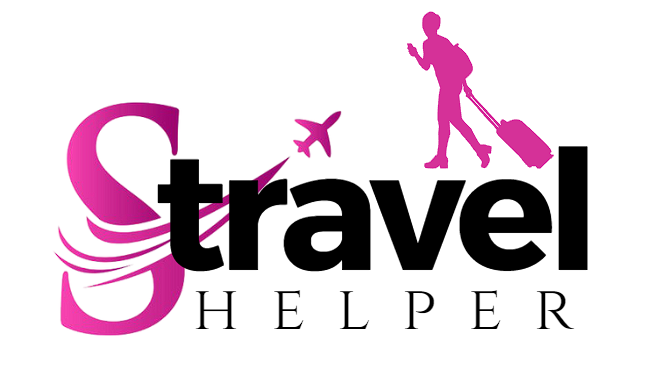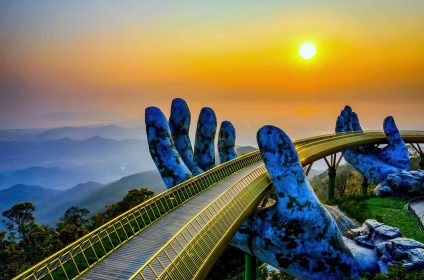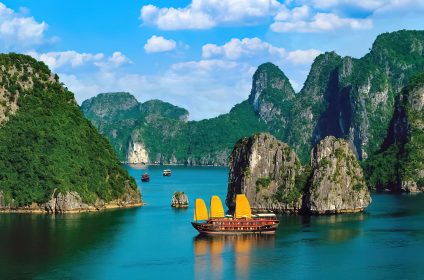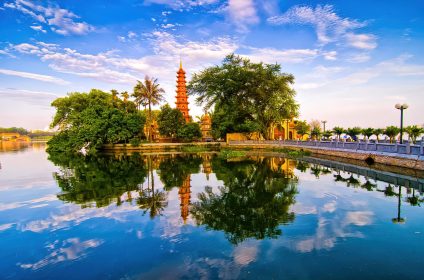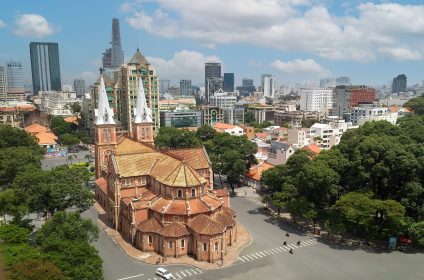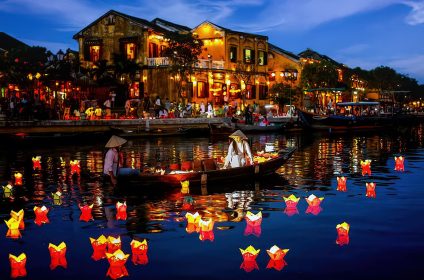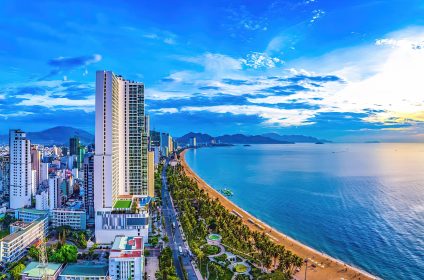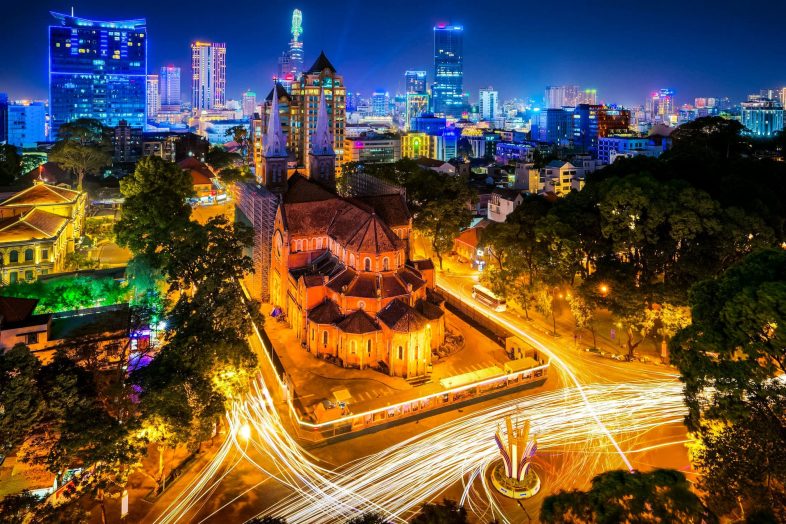
Vietnam
Vietnam is Southeast Asia’s easternmost country on the Indochina Peninsula. It has an estimated population of 90.5 million in 2014, making it the world’s fourteenth most populous nation and the eighth most populous country in Asia. On its north lies China, on its northwest is Laos, Cambodia to southwest and across South China Sea to southeast Malaysia. Vietnam officially unified in 1975 after Hanoi became its capital again.
It was part of Imperial China as a province from 111 BC up until AD 939 for almost one millennium. A separate Vietnamese state began after their victory over Chinese at Battle of Bach Dang River in 939AD. By the time that successive royal dynasties took place until mid-19th century, French colonists had already occupied all of Indochina Peninsula except Vietnam which grew politically and geographically into a kingdom during the course their rule in Southeast Asia.Thereafter came Japanese involvement in First Indochina War culminating in Vietnamese fighting for independence against France who held onto their lands up to the outbreak of World War Two thus driving them out in1954. This war resulted into two nations hating each other; north and south were sworn enemies. Eventually they turned against each other leading to heavy casualty figures among themselves with U.S.A also being involved as a third party resulting to one of America’s longest ever fought wars that ended when North Vietnamese screamed “we’ve taken Saigon”and invaded it.
However, this united under communist regime still remained poor and isolated politically (Economist Intelligence Unit Limited., Economist Newspaper Limited (Great Britain), & Financial Times Limited., 2008). The government introduced economic and political reforms thereby making Vietnam embrace globalization since year1986 (Archer & Gao, p104). But from there it turned out to be the fastest growing economy in the world as shown by its ranking number one among eleven major countries according to Global Growth Generators Index that was released as late as2011 (ibid.). A successful economic reform process lead to Vietnam gaining membership of World Trade Organization in 2007. It is a member of Organisation Internationale de la Francophonie since its creation. There are only four countries in the world where there is one party regime and communism openly proclaimed, and Vietnam is one of them.
Vietnam - Introduction
GDP
Currency
Area code
Population
Area
Official language
Independence from China
Time zone
Tourism In Vietnam
Due to enormous public and private capital specially focused on the coastal areas, Vietnam has become a major tourist destination since the 1990s. In 2009, Vietnam received approximately 3.77 million foreigners. Some of the favorite locations for visitors are the historical Imperial capital Hue, UNESCO World Heritage sites Phong Nha-K Bàng National Park, Hoi An and Mỹ Sơn as well as coastal cities like Nha Trang that has caves in Ha Long Bay and the Marble Mountains. Several leisure projects are in progress including one referred to as “Binh Duong Resort Complex” – being the largest man-made seawater lake in South East Asia.
Normally, December through April is considered as the best time to visit Vietnam because of cooler and drier weather conditions suitable for sightseeing or other outdoor activities. Daytime temperatures reach up to around 20 degrees Celsius (68 Fahrenheit) but it can drop down during night hours to about 10 degrees Celsius (50 Fahrenheit). However, from May until October, there is a change in weather patterns characterized by increased temperatures due to monsoon periods which raise humidity levels within the area.
Weather & Climate In Vietnam
The country has three climatic zones : north, central and southern. In Vietnam, the weather is varied according to the seasons and regions. The North of the country experiences two seasons: dry (October-March) and wet (April-September).
During dry season, temperatures usually range from about 15 -20°C making it cool and dry but in contrast wet season is characterized by heavy rains, high humidity with occasional typhoons where temperatures usually range from 25 – 30°C.
In the center region this two major categories are recognized; for example there exists a dry period which starts from January through August and another rainy period that comes between September to December.
It does not rain much during this time of year but there may be few showers. The highest temperature ranges between 24-30°C while in most times, floods come but sometimes typhoons also occur that are associated with wetness.
The South of the country can be divided into two different seasons; a long arid spell stretching from November up to April then a short rainy one beginning May ending October.
Geography Of Vietnam
Vietnam, a country in Southeast Asia, has a land area of approximately 331,212 km2 (127,881 square miles), and is bordered by China on the north; Laos to the northwest; Cambodia on its southwest and easten borders and south which border the South China Sea.
The country is divided into five main regions: The Red River Delta located in Northern Vietnam; The Central Highlands; The Northern and Central Coastal Region’s as well as the Mekong River Delta at the southernmost part of Vietnam together with Western Upland. Every section possesses unique geographical features, climates and cultures.
This region has extreme population densities and also for agricultural purposes it is very fertile especially for rice farming since it is plain land.
It has mountainous areas that have cool climate characterized by undulating peaks, dips and plateaus. In addition to sandy beaches on either side there are lagoons along this narrow strip of land that runs the length of this country.
Rice paddy fields along mekong river dominate this region where agriculture depends mainly on other crops like fruits grown in orchards.
Demographics Of Vietnam
Vietnam is the 15th most populous country in the world with about 97 million people. It comprises of fifty four different ethnicities out of which the largest one are Kinh who constitute around 85% of the total population.
Minority groups include Tay, Thai, Muong, Khmer and Hmong. There are also a few Chinese, Cham and Hoa among others. Of the population only approximately 35% lives in towns or cities while majority live in rural areas.
Vietnam has two biggest cities, Ho Chi Minh City (formerly Saigon) and Hanoi; both urban centers have relatively young populations since over a third (33%) of their residents are aged below 25 years. Males born there have an average life expectancy is around seventy three while for females it is eighty years.
Vietnam’s population has experienced tremendous growth over the past decades. Nevertheless, this pace recently decreased and it will probably stabilize also for future generations to come.
Religion In Vietnam
Vietnam has been largely influenced by religion in its history and culture. Buddhism is practiced by approximately 70% of the Vietnamese people, while Catholics make up about 12% and other religious groups such as Cao Dai and Hoa Hao have about 6%.
Buddhism entered Vietnam in the second century AD and since then it has played an important part in shaping the country’s culture. Most famous sites such as Hue’s Imperial City or Perfume Pagoda are closely connected to Buddhist pagodas and monasteries.
Catholicism was introduced into Vietnam by French missionaries during the colonial era, leaving a strong impact on several parts of the country, mainly southern regions that were mostly under French influence. The Vietnamese Catholic Church was greatly involved in the nation’s freedom struggle during mid-20th century.
In early twentieth century other religions emerged like Cao Dai and Hoa Hao which are indigenous to this land only. These incorporate aspects of Taoism, Confucianism, Buddhism and Christianity hence capturing great numbers of followers.
Language In Vietnam
Vietnam’s language is full of diversity since it has many languages which are spoken in all regions. The official language is Vietnamese, and a majority of the people speak it.Vietnamese belongs to the Austro-Asiatic family of languages and is closely related to Cambodian and Mon-Khmer.Asides from Vietnamese, there are more than fifty ethnic minority languages such as Chinese, Khmer, Thai.
Amongst them all, Chinese is most widely spread among the Hoa people, an ethnic Chinese minority living in Vietnam. Moreover, there are also regional variations of Vietnamese throughout the country that may differ in pronunciation vocabulary or grammar.
Notably among these dialects are the Northern Vietnamese, Central Vietnamese and Southern Vietnamese. On the whole, Language shapes Vietnam’s culture and identity; its dialectical differences reflect its colonial history of foreign rule as well as migration and cultural exchange over centuries.
Internet & Communication In Vietnam
The use of internet and communication has exploded over the last decade. The country has experienced a boom in telecommunications infrastructure development, while the government is making significant efforts towards promoting digitalization.
Vietnam has approximately 68 million internet users as of January 2021 representing about 69% of its total population. In Vietnam alone, there are around 50 million mobile phone subscriptions that connect to the internet using smartphones.
There are 130 million mobile phone subscriptions which is much higher than the entire population implying it’s higher penetration. Major telecommunication companies operating in the country included Viettel, Mobifone among others.
Social media platforms are very popular. Facebook is used by most with almost 60 million active people in January 2021. Also, Vietnam is one of Tiktok’s fastest-growing countries with almost ten million followers. Vietnamese use WhatsApp, Viber, Zalo and Skype for communications as well.
Economy Of Vietnam
Vietnam’s economy has experienced tremendous growth over the last few decades. The country shifted from a centrally planned economy to one that is market-based, following the economic reforms of 1986, also known as “Đổi Mới”.
Mostly driven by manufacturing, agriculture, and service sectors, Vietnamese economy relies on them for its development. Manufacturing has been an important driver of economic growth and turning Vietnam into a hub for the production of electronics, textiles, footwear, and furniture.
The agricultural sector employs many people with rice, coffee and seafood being grown primarily for exports. Tourism has expanded in the country within recent times while financial services have also developed considerably; telecommunications are among other service providers in this state.
With stunning natural landscapes and rich cultural heritage every year millions of tourists flock to Vietnam. On account of trade liberalization policies that brought about an entry into the WTO in 2007 as well as signing various FTA’s by Vietnam.
Vietnam Travel Guide
Vietnam is a land of contrasts, where modernity meets tradition. Vietnamese people take pride in their history while at the same time they are willing to adapt to the demands of the 21st century. This can be seen in their clothes, work, play and how they communicate. Vietnam’s population is one of the youngest in the world with over half of its 97 million inhabitants being below 35 years old. They are educated, tech-savvy and entrepreneurial-minded young people. Additionally, they are friendly and open up easily about other races. They love to tell visitors stories, give them opinions or share with them what excite them most. You will not become tired or lonely in Vietnam because there is always something going on and someone to chat with.
Vietnam offers a variety of delicious meals making it a foodies paradise. The geography, climate change and historical background have all contributed towards forming Vietnamese cuisine which has five basic tastes that include sweet, sour, salty as well as bitter and hot flavors. The cooking makes use of fresh herbs vegetables fruits together with fish sauce rice noodles among others.Vietnamese cuisine is also famous for spring rolls bún chả(noodles with grilled pork), phở(soup) bánh mì (sandwich) etc., which are available at street stalls markets restaurants even homes too.Vietnamese foods are cheaply sold hence affordable for everyone irrespective of social class because they cost less than $5.
Vietnam country has a variety of breathtaking landscapes.This Asian nation boasts majestic mountains then lush paddy terraces followed by tropical islands; something for everyone’s taste buds.Therefore you can explore scenic areas like Sapa Halong Bay Phong Nha Nha Trang through hiking biking kayaking cruising – these places right here.Their biodiversity includes some rare species such as Indochinese tiger giant ibis , Asian elephant etc.This gives you an opportunity to experience different things which will make your body and soul really happy if you are in love with nature.
Vietnam is a multi-cultural country that has existed for 4 thousand years. Vietnam’s many different cultures have been brought on by civilizations from China, India, France, and the United States of America. However, Vietnam itself has produced an authentic culture including its own language, literature art music as well as religion. Some of cultural treasures include Hue Hoi An and My Son which are all UNESCO World Heritage Sites. Also there is a lot of modern art cinema fashion pop music etc in today’s Vietnam that is very creative.Vietnam can identify with both its history and current developments or future progressions.
Vietnam is a country of cities’ delights, with various towns to fascinate both your interest and imagination. You will find Vietnam’s city for any mood and taste, from the capital Hanoi, which has attractive colonial buildings and vibrant Old Quarter to Hue-a former imperial city with its grand citadel and royal tombs to Ho Chi Minh City-an urbanized place full of tall buildings and nightlife. In each city you can explore the history, culture and cuisine as well as shopping centers, entertainments centers among other leisure activities. The locals are also friendly people whom you can interact with thereby enabling you to feel the energy and experience every corner of the place. Not only lively but they are also beautiful-Vietnamese cities.
Vietnam is a country of stunning views by sea; it has curved coastlines that make it a perfect tourist destination. Over 3000 kilometers long coastline in Vietnam is marked by numerous islands, bays along with fishing villages. These destinations include Da Nang, Nha Trang Phu Quoc Island, Mui Ne among others where you can enjoy sun bathing day after day at some of them whenever you please. On the same note that we have examples such as Quy Nhon Con Dao or Phan Rang which happen to be less known coastal spots but still deserve attention because there are hidden treasures waiting to be revealed here too! The coast line of Vietnam has something for everybody from thrilling escapades to romantic moments or just relaxation needs.
Entry Requirements & Visa For Vietnam
The phu quoc island’s visa requirements have been lifted by the vietnamese government to boost tourism. Visitors are permitted to stay up to 15 days and can apply for a legitimate vietnamese visa at a local immigration office. All passports must be valid at least forty-five days after arriving in Phu Quoc.
Most of the embassies and consulates of Vietnam accept online applications for visas. On condition that their passport is still valid, Vietnamese foreigners can obtain a visa exemption allowing them to enter multiple times for three months each. Meanwhile, the tendency of having Visa on Arrival is becoming more popular because it’s much cheaper and eliminates any need for dispatching passports back home via Vietnamese embassy.
An e-visa allows only one entry with no possibility to exceed thirty days before departure, while the two most common ports should be selected before filling in this application form. Consequently, if travel arrangements fall within those constraints then e-visa is the cheapest, fastest and safest mode of traveling. Passports should have two empty pages at least and remain valid within another month from date of entering so they can receive an entry stamp.
How To Travel To Vietnam
Vietnam has a bevy of options for getting around, from motorcycles to planes to overland trains and buses. The fastest way to get across the country is by plane and flights connect Hanoi and HCMC with other major cities like Da Nang, Hai Phong, Can Tho, Hue, Nha Trang, Da Lat and Phu Quoc. However, the most practical method for land travel in Vietnam is by train.
The Reunification Express is the railway line linking Hanoi and Ho Chi Minh City built by the French in 1936. It takes 36 hours with stops at Hue, Danang, Nha Trang and Phan Thiet. Five daily services of Reunification Express run from both Hanoi and Ho Chi Minh City. There are four seat types: hard seats (D2), soft seats with air-con (A2), hard sleepers with air-con (B2) and soft sleepers with air-con (A1).
For Vietnamese people their favored mean of transportation is 110cc motorbikes; foreigners can’t ride motorcycles unless they have a temporary Vietnamese motorbike licence or an international licence valid in their home country. Cyclo-pedicabs are still popular especially in good-looking small towns such as Hue which are less crowded but often more expensive than motorbikes for the same distance.
How To Travel Around Vietnam
Vietnam has a wide range of transportation options like its scenery. From flying point to point, riding through the wind on a motorcycle, to overland routes by trains and buses with views as you go, there are few limitations on where you can typically go with just a little planning (and a sense of adventure).
Some towns have many taxis, buses and cyclos while cycling is sometimes tempting in the countryside. The quickest means of travelling across this long country is a flight. It takes two hours at most from Hanoi to HCMC by plane. Numerous flights connect Vietnam’s two largest cities – Hanoi and HCMC to such large cities as Da Nang, Hai Phong, Can Tho, Hue, Nha Trang, Da Lat or Phu Quoc.
Most Vietnamese cities are linked by long-distance buses. A majority leave early mornings so that they can cope with traffic and avoid rain in late afternoons; some travel at night. The key point to keep in mind here is that despite inter-city travels average speeds tend to be quite low along roadways. For example it will take around 8 hours for a bus trip of approximately 276 km from Mekong Delta to Ho Chi Minh City. Although more costly than travelling on a bus train maybe one of the most convenient ways for tourists who wish to see the country by land within Vietnam.
Destinations in Vietnam
Vietnam has numerous tourist attractions for all sorts of tourists including culinary tourists, history buffs, adventurous types and nature lovers. One of the UNESCO World Heritage Sites is Ha Long Bay, which is famous for boat tours and limestone formations. Hanoi’s capital city combines two different traditions (Eastern and Western) with its eating places, temples or pagodas as well as museums.
South of Da Nang is Hoi An which makes visitors fall in love with its sandy beaches and delicious meals in the Old Quarter . Located in Northern Vietnam, Sapa offers great ethnic experiences to enjoy through nice walking trails , Go outside busy urban centres to find breathtaking hikes along beautiful terraced farming areas and other landscapes that characterize it. For Hue has Cuisine Heritages such as tasty foods also ancient remains plus royal tombs of the olden days are a common feature found countrywide.
Phu Quoc Island resembles a tropical haven featuring powdery sand beaches, crystal-clear water and heavenly sunsets. In Ninh Binh province located up north you can enjoy riverboat rides over rice paddies; through old townships and across limestone monoliths. Much more than just being a food destination alone, Da Nang also boasts fine coastlines.
Attractions & Things To See in Vietnam
Vietnam is popular for possessing diverse attractions such as cliffs, beaches, islands, mountains, plains and lakes. Ha Long Bay is a fantastic site encompassing over 1,600 karst islands and tiny islets where people can plan their trips as they wish- including cave exploration and visiting flooded settlements.
Hoi An Ancient Town has an array of old quarters with nice lanterns and many shopping outlets; besides that it provides various spots to eat Vietnamese dishes. Ho Chi Minh City (formerly Saigon) epitomizes Vietnam’s economic power with War Remnants Museum representing its past and busy markets which are a source of cultural experiences.
The Hue Imperial City showcases the grandeur of Vietnam’s feudal era through its palaces, temples and pavilions where you might savour the Bun Bo Hue noodle soup. The Northern Upland region has Sapa which attracts hikers not only because of trekking routes to tribal villages but also for stunning sceneries from mountain peaks that offer peace away from urban noise.
Activities & Things To Do in Vietnam
As a stunning and diverse country, Vietnam has a lot to offer to its visitors. Hanoi and Ho Chi Minh City are home to lively markets, temples and museums with crowded streets leading to Ha Long Bay which is renowned for having towering limestone pillars and green islands (a UNESCO World Heritage site) – one can never get bored of activities here.
For history enthusiasts, taking the time to visit the Cu Chi Tunnels near Ho Chi Minh City will provide you with an amazing experience regarding the underground system used by Vietcong soldiers during war. More so, no person can ever leave Vietnam without trying out some street foods like Banh Mi sandwiches or Pho noodle soup
Vietnam boasts some of the most beautiful beaches in Southeast Asia where tourists can either lie on white sandy shores or take part in diving, snorkeling and swimming. Because it has a rich culture, beautiful places and foods from all over the world this is one of those tourist spots that should not miss on any traveler’s list.
Beaches In Vietnam
Vietnam is known for its beautiful coastlines and lovely beaches, below are some of the finest beaches;
- Nha Trang Beach – Positioned in the south region, Nha Trang is one of those places that people go to enjoy long stretches of white sandy beach and transparent waters. This is a famous resort beach with a calm environment.
- Phu Quoc Island– It has got the cleanest blue water and pristine beaches thus making it the leading destination for the beach lovers; The island prides in possessing several beaches each having its own uniqueness.
- Da Nang Beach— Da Nang located along central coast is a city situated along the central coast that has some of the most stunning oceanic sites in Vietnam. It has long stretches of sand which are golden making them suitable for swimming among other sports.
- Mui Ne Beach – Mui Ne is small coastal town in the southern area that has breathtakingly beautiful beaches and deep turquoise water. Besides being home to these picturesque beaches, this beach destination is also famous for windsurfing as well as kite surfing.
Food & Drinks In Vietnam
Vietnamese food is rich in flavour, smell and variety that mirror the country’s geography, history and culture. Street food has become part of Vietnam’s tradition available almost everywhere in any given neighborhood or market. Here are some must-try foods and drinks:
- Pho: Pho is a noodle soup made from rice noodles served with your choice of meat or tofu, fragrant herbs and a fish bone/beef bone/vegetable stock as the tasty broth. It is typically accompanied by freshly sprouted bean sprouts, lime wedges and various kinds of herbs for garnish.
- Banh Mi: Banh mi is a Vietnamese traditional sandwich containing pate, cilantro pickles as well as different types of meats like pork, chicken or fish.
- Bun cha:Bun Cha is a type of grilled pork patties over rice noodles dish among others in Hanoi which uses a dipping sauce made from sugar, lime juice chili pepper ,fish sauce.
- Pho Cuon: Pho Cuon refers to spring rolls that are composed of steamed rice noodle sheets filled with minced meat along side lettuce leaves combined with mixed herbs.
Money & Shopping In Vietnam
Vietnam’s official currency is the Vietnamese dong (VND), however, US dollars are widely accepted especially in tourist areas. For effective shopping while in Vietnam, it is recommended to exchange currency before the trip or use ATMs upon arrival since they are available in most cities.
Major credit cards are also acceptable at the big establishments. Bargaining is a typical behavior particularly among markets and small stores where haggling should be expected from visitors. The freshest fruits and vegetables can be found at local markets such as Ben Thanh Market in Ho Chi Minh City and Dong Xuan Market in Hanoi which have souvenirs and local products in plenty during mornings.
In urban areas such as Ho Chi Minh City and Hanoi, there are several shopping malls for those who prefer Western-style shopping. Normally, provided that they consider currency exchange rates, ready to negotiate on prices and transact with cash some of it therefore, purchasing things in Vietnam can be fun to visitors.
Nightlife in Vietnam
A visit to Vietnam is an opportunity to sample a pulsating, diverse and profuse nightlife. Each Vietnamese town has got its own unique nightlife, from vibrant metropolitan cities to quiet beach towns.
Vietnam’s nightlife is found in Ho Chi Minh City. It has pubs, clubs, skybars and places with live music shows. Among other night life known Dong Khoi Street, Bui Vien Street or Pham Ngu Lao Street are the most famous ones of them.
Hanoi is different from Ho Chi Minh City as it possesses a more traditional nocturnal atmosphere that is peaceful at the same time. Local beer can be enjoyed in cafes or pub combined with water puppetry shows or live bands playing local music. Around Hoan Kiem Lake and Old Quarter are the best spots for evening hangouts.
Da Nang though is not only another pretty city with beautiful beaches but also one of those places where tourists prefer partying outside than sleeping till dawn breaks up. There are plenty of lovely little cafés which serve refreshing drinks while you watch the sea roll by as well as rooftop bars situated next door to beach clubs on this side.
Festivals & Holidays in Vietnam
A culturally rich country, Vietnam holds various festivals across the year. Whether traditional festivals that have been around for centuries or contemporary festivals that exhibit Vietnam’s modern music and art, there is always something going on in this country.
- Tet Nguyen Dan: Also called Vietnamese New Year it is considered as the most significant and widely celebrated holiday. It falls either in late January or early February where families meet, feed and pay homage to their ancestors.
- Hue Festival: This two-year celebration which takes place in the former imperial city of Hue showcases the city’s cultural heritage through dance, food and art. Culture lovers cannot miss this festival whose performers come from all over the world.
- Hoi An Lantern Festival: Each month on 14th day following Lunar Calendar is a colorful lantern festival at Hoi An ancient town. The streets are lit by floating lanterns while traditional tunes fill up the air.
Traditions & Customs in Vietnam
Viet Nam is a country steeped in cultural diversity and a wide-ranging past which have shaped many idiosyncratic mores and customs. In Vietnamese culture, Tet or Lunar New Year is one of the most important events. This is a season for families to come together, pay tribute to their ancestors and eat “banh chung”.
A number of people in Vietnam carry out ancestor worship with faith that their forefathers’ spirits defend them against danger and lead them on the right path. The prevalent use of meditation plus temple gifts reveals that Buddhism plays an indispensable role in shaping Vietnam’s society.
Vietnamese cuisine is famous worldwide for its lip-smacking flavors and now dishes like pho, banh mi, spring rolls are gaining more popularity than ever before.There are also numerous festivals throughout the country such as the Hue Festival, Hung Kings Festival and Mid-Autumn Festival which indicate how culturally rich Viet Nam is today.
Culture Of Vietnam
Vietnamese culture is a fascinating blend of different influences, local myths and outside powers that have contributed to a unique and distinct lifestyle. Chinese, Khmer, French colonization as well as its own rich history and heritage over centuries has also influenced Vietnamese culture.
Vietnam’s rich history and mythology are reflected in art, music, and literature of the country. Some ancient legends like the story of the dragon and fairy continue to be told from one generation to another. Major religions practiced in Vietnam include; Buddhism together with Taoism but there are also Catholics & Protestants too. Many Vietnamese follow ancestor worship in which they make offerings for their dead relatives.
Vietnamese food is famous for its tasty yet nutritious dishes. Common foods include rice, noodles or seafood cooked with herbs such as coriander or mint leaves. Traditional musical instruments in Vietnam comprise dan bau (one-stringed instrument), dan tranh (a plucked instrument) or bamboo flute etcetera. Traditional Vietnamese dances which often communicate stories using intricate body movements are also vital parts of this culture.
Stay Safe & Healthy In Vietnam
Vietnam is a pretty safe country, especially when you are in groups. Still, towns experience common cases of pickpocketing and motorcycle thefts. Don’t put your luggage on your shoulder when riding a motorbike and placing it in the basket of bike is not good either. Even luxury hotels have recorded cases where property has been stolen from rooms.
Petty larceny is still alive issue, especially within the major cities. In crowded streets or at intersections do not stretch out cameras and phones while taking photos of sidewalks keep camera close to your body. Put them in a safe or lock them inside your suitcase before you leave your hotel room in a hotel or guesthouse.
Sexual exploitation of women and children is forbidden with 20 years’ imprisonment as maximum penalty by Vietnamese law. Furthermore, taking a Vietnamese national into one’s hotel room amounts to an offence against Vietnam’s law whereby defaulters such person risk two more dangers: HIV/AIDS is prevalent throughout Vietnam and there is potential for theft when bringing unfamiliar female into lodging place.
